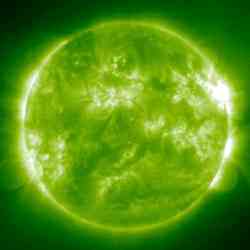
Solar flare. Image credit: ESA Click to enlarge
Boston University astronomers announced today the first clear evidence that solar flares change the upper atmosphere of Mars. In an article published in the February 24th issue of the journal Science, the researchers describe how X-ray bursts from the Sun in April 2001 recorded by satellites near Earth reached Mars and caused dramatic enhancements to the planet’s ionosphere ??bf? the region of a planet’s atmosphere where the Sun’s ultraviolet and X-rays are absorbed by atoms and molecules. The measurements were made by the Mars Global Surveyor (MGS) spacecraft at the Red Planet as it transmitted signals to NASA’s antenna sites back on Earth.
“On April 15th and 26th of 2001, radio signals from MGS showed that the Martian ionosphere was unusually dense, and this was the clue that some extra production of ions and electrons had occurred,” explained Michael Mendillo, professor of astronomy, who led the BU research team in its Center for Space Physics.
“At Earth, the GOES satellites measure the Sun’s X-rays almost continuously,” said Dr. Paul Withers of BU. “Our search of their large database discovered several cases of flares occurring just minutes before MGS detected enhancements in Mars’ ionosphere.”
The extra electrons produced by the Sun’s X-rays cause subtle changes in how the MGS radio waves travel toward Earth. Therefore, the team wanted to find several unambiguous case study events before announcing their findings.
The Radio Science Experiment on MGS has made observations of Mars’ ionosphere since its arrival there in late 1999. Its radio transmissions are received by NASA and then cast into scientifically meaningful data by Dr. David Hinson at Stanford University who provides open access to researchers worldwide via a Web site. “We needed Dr. Hinson’s expert advice to make sure that some odd changes in the MGS radio signal had not occurred just by chance,” Dr. Withers added.
To confirm that the photons from these flares had sufficient fluxes to actually modify an ionosphere, additional evidence was sought using measurements on Earth. “During this period, the Sun, Earth and Mars were nearly in a straight line and thus the X-rays measured at Earth should have caused enhancements here as well as at Mars,” Mendillo added.
Using several ionospheric radars spread over the globe, operated by scientists at the University of Massachusetts/Lowell, Professor Bodo Reinisch confirmed that the Sun’s X-rays caused equally impressive modifications to Earth’s ionosphere at the precise times required on those days.
“The science yield from this work will be in the new field of Comparative Atmospheres,” Mendillo pointed out. “By that I mean studies of the same process in nature, in this case making an ionosphere on two planets simultaneously, offer insights and constraints to models not always possible when studying that process on a single planet. The fifth member of our team, Professor Henry Rishbeth of the University of Southampton in England, provides the expertise in theory and modeling that will be the focus of our follow-up studies.”
Founded in 1839, Boston University is an internationally recognized institution of higher education and research. With more than 30,000 students, it is the fourth largest independent university in the United States. BU contains 17 colleges and schools along with a number of multi-disciplinary centers and institutes which are central to the school’s research and teaching mission.
Original Source: Boston University
